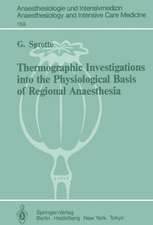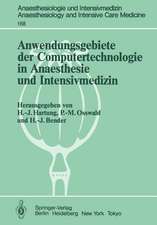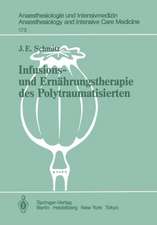Deer's Treatment of Pain: An Illustrated Guide for Practitioners
Editat de Timothy R. Deer, Jason E. Pope, Tim J. Lamer, David Provenzanoen Limba Engleză Hardback – 24 aug 2019
Preț: 1082.40 lei
Preț vechi: 1139.38 lei
-5% Nou
Puncte Express: 1624
Preț estimativ în valută:
207.14€ • 214.95$ • 173.13£
207.14€ • 214.95$ • 173.13£
Carte tipărită la comandă
Livrare economică 11-17 martie
Preluare comenzi: 021 569.72.76
Specificații
ISBN-13: 9783030122805
ISBN-10: 3030122808
Pagini: 953
Ilustrații: XXVI, 854 p. 339 illus., 222 illus. in color.
Dimensiuni: 210 x 279 x 49 mm
Greutate: 2.13 kg
Ediția:1st ed. 2019
Editura: Springer International Publishing
Colecția Springer
Locul publicării:Cham, Switzerland
ISBN-10: 3030122808
Pagini: 953
Ilustrații: XXVI, 854 p. 339 illus., 222 illus. in color.
Dimensiuni: 210 x 279 x 49 mm
Greutate: 2.13 kg
Ediția:1st ed. 2019
Editura: Springer International Publishing
Colecția Springer
Locul publicării:Cham, Switzerland
Cuprins
PART 1: INTRODUCTION.-The Disease-Based Treatment of Pain.- Algorithms of Pain Treatment .-The Opioid Epidemic and the Need for a Pain Strategy.-PART 2: ANATOMY AND PHYSIOLOGY OF PAIN.-Nerve Function and Neurons.-Peripheral Nerve Anatomy.-Spinal Cord Anatomy.-Anatomy of the Brain and Brainstem.-Mediators of Pain and Pain Processing.-Taxonomy of Pain.-Pain Relieving Mechanisms in Neuromodulation.-PART 3: PSYCHOLOGY OF PAIN.-The Normal Response to Pain.-Pain and Suffering.-Social Impact of Pain Response.-Role of Religion and Spirituality in the Patient Pain Experience.- Anxiety and Depression in Patients with Chronic Pain.-Psychological Treatments to Improve Outcomes.-Psychological Evaluation for Those Receiving Devices for the Treatment Of Pain.-PART 4: PHARMACOLOGICAL TREATMENT OF PAIN.-Acetaminophen and Nonsteroidal Anti-inflammatory Drugs.-Anticonvulsants in the Treatment of Pain.-Botulinum Toxin.-Sodium Channel Antagonists.-Anti-Spasmodics and Muscle Relaxants.-Antidepressants in Pain Management.-Ketamine and NMDA-Receptor Antagonists.-Novel Analgesics.-Injectable Corticosteroids.-Topical Therapies.- Opioids for Chronic Non-Cancer Pain.-Opioids for Cancer Pain and Hospice Care.-Pharmacogenetics and Pharmacogenomics of Pain Treatment .-PART 5: INTERVENTIONAL TREATMENT OF PAIN.-Radiation Safety.-Radiofrequency Ablation.-Basic Science of Radiofrequency.-Cryotherapy.-Chemodenervation: Neurolytic Blockade and Potent Neurotoxins for the Treatment of Cancer Pain.- Blockade of the Nerves of the Head and Face.-Ganglion Blocks of Head and Face.-Destructive procedures of the Head and Face .-39. Interlaminar Approach for Cervical Epidural Steroid Injection.-Cervical Transforaminal Epidural Injections.-Diagnostic Cervical Nerve Root Blocks.-Cervical Facet Joint Injection and Medial Branch Blocks .-Cervical Facet Radiofrequency Neurotomy.-Intercostal Nerve Block.-Intercostal Nerve Block.-Thoracic Interlaminar Epidural Steroid Injection.-Thoracic Facet and Medial Branch Blocks.-Radiofrequency Ablation in the Thoracic Spine.-Lumbar Interlaminar Epidural Injection.-Lumbar Transforaminal Epidural Corticosteroid Injections.-Lumbar Facet and Medial Branch Block.-Sacroiliac Joint Injection .-Sacroiliac Joint Radiofrequency.-Sacroiliac Joint Fusion.-Caudal Epidural Injection.-Stellate Ganglion Block.-Lumbar Sympathetic Block.-Celiac Plexus Block and Superior Hypogastric Plexus Block.-Ganglion Impar Block.-Large Joint Injections.-PART 6: NEUROMODULATION.- Deep Brain Stimulation.-Motor Cortex Stimulation.-Occipital Nerve Stimulation.-Sphenopalatine Ganglion Block.-Percutaneous Cervical Spinal Cord Stimulation.-Surgical Leads for the Cervical Spine.-Dorsal Root Ganglion Stimulation–Cervical Spine.-Percutaneous Thoracic Neurostimulation for Chronic Pain.-Surgical Lead for the Thoracic Spine.-Percutaneous Lumbar Stimulation.-Thoracic and Lumbar Dorsal Root Ganglion Spinal Stimulation.-Percutaneous Sacral Nerve Stimulation.-Sacral Dorsal Root Ganglion Spinal Stimulation.-Peripheral Nerve Stimulation.-Stimulation Methods and Device Choices: Dorsal Root Ganglion Stimulation, Spinal Cord Stimulation, and Peripheral Nerve Stimulation.-Patient Selection.-Wound Closure and Surgical Healing.-Complications of Neuromodulation.- PART 7: NEUROAXIAL THERAPIES.-Intrathecal Pharmacology.-Patient Selection.- Intrathecal Device Considerations.-Intrathecal Agents and Algorithms: Review of PACC 2012 and 2017 Guidelines and Beyond.-Implantable Drug Delivery Systems for Cancer Pain and End Of Life Care.-Intrathecal Drug Delivery Systems for Chronic Non-Cancer Pain.-IDDS For Movement Disorders.-Ziconitide for Intrathecal Use.-PART 8: REGENERATIVE THERAPIES FOR CHRONIC PAIN.-Scientific Bases of PRP Therapy.-Scientific Basis for Stem Cell Therapy.-Stem Cells.-Regenerative Therapies for Chronic Intradiscal Pain.-PRP Therapies (Tendons, Joints, Spine) .-PART 9: INTRADISCAL AND MINIMALLY INVASIVE STRUCTURAL SURGERIES.-Discography.-Endoscopic Discectomy.-Vertebral Augmentation for Painful Vertebral Compression Fractures.-Vertebroplasty and other methods of vertebral augmentation.-Minimally Invasive Lumbar Decompression.-Interspinous Process Spacers for Indirect Lumbar Decompression.-PART 10. REHABILITATION AND ADJUVANT THERAPIES FOR PAIN.-Physical Therapy.-Acupuncture.-PART 11. ADMINISTRATIVE CONSIDERATIONS.-Cybersecurity of Medical Devices: Past, Present, and Future.- Coding and Billing.-Medicare Payment Quality Measures.-
Recenzii
“The intended audience is physicians committed to treating pain patients in an optimal fashion. Although medical students or residents in anesthesia may find this book useful as reference, it probably is most appropriate for the libraries of fellows in pain management and pain physicians interested in a procedural approach to the pain patient in the context of a multidisciplinary setting.” (Paul D Ware, Doody's Book Reviews, November 08, 2019)
Notă biografică
Timothy R. Deer, MD, DABPM, FIPP
President and CEO
The Spine and Nerve Center of the Virginias
Charleston, West Virginia
USA
Jason E. Pope MD, DABPM, FIPP
Evolve Restorative Center
Santa Rosa, California
USA
Tim Lamer, MD
Mayo Clinic
Department of Anesthesiology and Perioperative Medicine
Rochester, Minnesota
USA
David Provenzano, MD
Pain Diagnostics and Interventional Care
Sewickley, Pennsylvania
USA
President and CEO
The Spine and Nerve Center of the Virginias
Charleston, West Virginia
USA
Jason E. Pope MD, DABPM, FIPP
Evolve Restorative Center
Santa Rosa, California
USA
Tim Lamer, MD
Mayo Clinic
Department of Anesthesiology and Perioperative Medicine
Rochester, Minnesota
USA
David Provenzano, MD
Pain Diagnostics and Interventional Care
Sewickley, Pennsylvania
USA
Jason Pope, MD is the President of Summit Pain Alliance. He was recently appointed to the North American Neuromodulation Society (NANS) board as a Director-at Large and served as a fellow to a member of the House of Representatives Energy and Commerce Sub-committee on Health and was the recipient of the first annual American Society of Interventional Pain Physicians (ASIPP) Fellow’s Advocacy Grant. He served as a member of the West Virginia Pharmacy Board Advisory Panel of Controlled Substances and Opioid Prescribing and is Secretary of the California Society of Interventional Pain Physicians (CASIPP). Dr. Pope has also helped foster the educational efforts of NANS, and has helped formalized the Resident and Fellow Section (RFS) of NANS, functioning as Co-Chair, and helped create a mentorship program for fellows. He helped develop the NANS Certificate of Attendance (COA) training opportunity to promote safe and efficacious employment of advanced pain care therapies. Dr. Pope is on the Planning Committee and the Scientific Committee for the NANS annual meeting and served as Co-Chair of the Resident and Fellows Section Pre-Conference Workshop, with the development of the first annual RFS Breakout Session during the Conference. Dr. Pope is the co-Chair of the inaugural Neuromodulation Special Interest Group (SIG) for the American Society of Regional Anesthesia (ASRA). He is also well published in peer-reviewed journals, authored many chapters, textbooks and atlases, while presenting at regional, national, and international meetings.
Timothy Lamer, MD is an Associate Professor of Anesthesiology at the Mayo Clinic whose research interests include: interventional therapies for intractable post-surgical neuralgias/neuropathic pain syndromes, Radiofrequency therapies for spine pain and head and neck pain, Spinal stimulation and/or nerve stimulation for chronic neuropathic pain, and Prolotherapy for sacroiliac joint pain.
David Provenzano, MD is the President of Pain Diagnostics and Interventional Care. He has served as a principal investigator on multiple research studies and published numerous scientific articles. His research interests include neuromodulation and theeffects of preinjected fluid on monopolar and bipolar radiofrequency lesioning. He has lectured at numerous international and national meetings on the management of acute and chronic pain. Furthermore, he serves as an external member of the Robert Morris University IRB, an Adjunct Assistant Professor at Duquesne University Department of Pharmacology, and Adjunct Clinical Instructor in the Department of Physician Assistants Studies at the Duquesne University Rangos School of Health Sciences. He serves on the Board of Directors of the American Society of Regional Anesthesia and Pain Medicine and the North American Neuromodulation Society. He is the Vice Chair for the ASRA Neuromodulation Special Interest Group. Dr. Provenzano previously served as the Vice Chair for the Continuing Medical Education Committee for the American Society of Regional Anesthesia and Pain Medicine. In addition, he serves on the Educational Track Subcommittee on Pain Medicine for the American Society of Anesthesiologists. He has extensive interests and expertise in the conservative treatment of pain originating from the cervical and lumbar spine, neuromodulation and in the utilization of ultrasound for interventional pain management procedures.
Textul de pe ultima copertă
Designed and written by a team of clinically established academics, this is a unique book that is an excellent manual for physicians practicing pain medicine or treating pain in neurosurgery, orthopedic, neurology, or family practice clinics. As a practical resource, this book is written to be more accessible to the reader and is designed to be more clinically-focused and useful in day-to-day practice. This 102 chapter volume is divided into seven separate sections: Anatomy and Physiology of Pain, Psychology of Pain, Pharmacological Treatment of Pain, Interventional Treatment of Pain, Adjuvant Therapies for Pain and Suggested Reading. The calculated organization of this book is supplemented by key photos, drawings and a self-assessment of four key questions at the end of each chapter -- thus making it an indispensable, pragmatic resource that will benefit anyone working in the pain management field. Deer's Treatment of Pain: An Illustrated Guide for Practitioners contains pearls for improving knowledge and improving one’s practice as a physician.
Caracteristici
Designed to be the go-to for physicians practicing pain medicine or treating pain in Neurosurgery, Orthopedic, Neurology, or Family Practice clinics Written by leading experts in the field to be more “accessible” to the reader and designed to be more clinically-focused and useful in day-to-day practice Each chapter includes basic and critical knowledge that will be useful for testing, refreshing for a procedure, drug or disease Includes dozens of key photos and drawings at the beginning of each chapter to enhance visual learning Includes a self-assessment of 4 key questions at the end of each chapter Includes pearls for improving knowledge and, when appropriate, outcomes




























